By Dominic and Margaret (Jolimont)
Botanical name: Ipomoea batatas family Convolulaceae
Common Name: Sweet potato, (or kumara in NZ)
Origins: From tropical regions of America, but they spread from there.
Description: Long and tapered edible tuberous root , smooth skin with color ranges between yellow, orange, red, brown, purple, and beige. Its flesh ranges from beige through white, red, pink, violet, yellow, orange, and purple.
Varieties: There are many varieties, (over 1000) but only some are available in Australia.
Did you know? Australia produces around 100,000 tonnes of Sweet Potatoes each year. Value: $80 million.
70% of these are in Qld, and most of the rest in NSW and W.A.
Most Common Varieties in Australia
All fresh market sweet potatoes sold in Australia are grown in Australia.
Gold Category: Beauregard
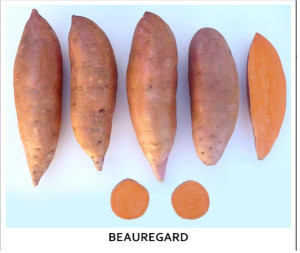
Rose/gold smooth skin, with a moderately deep orange flesh.
Developed by the Louisiana Agricultural Experiment Station in 1981.
This versatile variety lends itself to baking, boiling, mashing, or frying.
Has 90% of the market.
Red Category: Northern Star
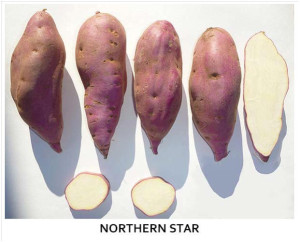
Has a red purple skin, with bright, white flesh including occasional purple areas. Its origin is Laloki, Papua New Guinea.
Second most popular, with around 8% of sales.
Purple Category: WSPF
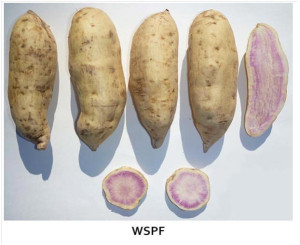
White skin, with white and purple flesh.
The current Aust. industry standard of purple-fleshed cultivar.
Less than 2% of the Australian Sweet Potato production.
Released in Qld in 2000.
White Category: Kestle
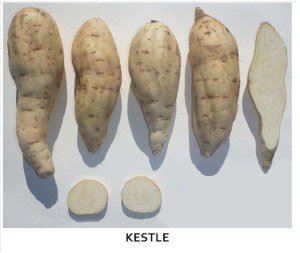
Has a white skin, with white flesh.
Original material came from Taiwan, with the resultant selection made 20‐30 years ago. Currently the principal white category cultivar grown for the commercial Australian sweet potato market.
Some of the following sweet potatoes may be available in Australia, but are not grown on a large scale. They may even come under another name.
Hawaiian Sunshine Drier flesh than Beauregard.
Excellent source of purple pigments, called anthocyanins, up to 150% more than blueberries. These pigments have been linked to fighting cancer, ageing, hypertension and neurological diseases, inflammation, diabetes and bacterial infections.
Speckled purple Flecked magenta flesh.
Remains firm when boiled or fried and has a mild, nutty flavor.
Envy An heirloom variety with pale orange skin and flesh, mild, moist, and sweet; a good choice for baking, roasting, and casserole.
Hannahs Have tan skin and an off‐white interior.
When baked, the flesh takes on a yellow cast, a lightly sweet flavor, and a dry texture – great when mashed.
Jewel With copper skin and deep‐orange flesh, moist and tender when cooked, is really good for traditional baking and casseroles.
Garnets Named for their red-purple skin, orange flesh that has a moist, heavy, pumpkin-like quality when baked in a sweet potato pie.
Korean purple An Asian heirloom variety, has speckled purple skin and white flesh. Baking or boiling coaxes out its chestnut-like flavour.
Creamsicle Named for its combination of cream-colored exterior and sugary, vibrant-orange interior, has firm flesh great for frying or boiling.
Purple sweet potatoes Have firm, lightly sweet flesh and a slight, pleasant tartness that takes well to generously seasoned savory roasted dishes.
Stokes purple potatoes are purple all the way through. Earthy and fibrous, they’re best baked at a low temperature because of their low moisture content.
General information:
Sweet potato varieties with white or pale yellow flesh are less sweet and moist than those with red, pink or orange flesh.
The sweet potato is also very nutritious, low in calories, fat free and cholesterol free. Excellent source of Vitamin A, Vitamin C, Potassium, Folate and Calcium.
Among root vegetables, offers the lowest glycemic index (GI) rating, because it is digested more slowly.
Orange-fleshed varieties are very rich in beta carotene and other carotenoids.
You can also eat the leaf tips and young leaves as spinach as they provide significant amounts of Vitamin C, B6, comparing well with fruits and vegetables such as broccoli, avocados, carrots, bananas, and cauliflower.
Growing Conditions:
Sun exposure: Full Sun
Soil type: Deep. Loose, friable, well drained.
Planting: Early Spring
Spacing: 40cm
Harvest: 4-6 months… storage increases flavour.
Soil pH: 4.5 to 7.5, but 5.8 to 6.2 is optimal.
The sweet potato is a warm-season, spreading vegetable of tropical origin, but will grow in Melbourne.
Easy to grow, drought and heat-tolerant, few pests or diseases.

Soil:
Dig soil to at least one spade depth.
Add compost – 2 buckets per square metre, or well rotted manure.
Mound soil into ridges for greater depth and drainage, especially in heavy soils.
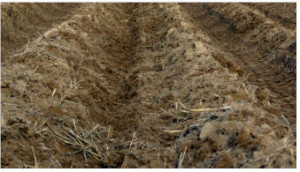
In some places, sweet potato ‘slips’ or cuttings can be purchased by mail order, but you can grow your own.
Sweet potatoes cuttings can survive in just water for a long time. Dominic S. will expand on this.
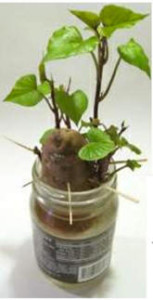
Plant cuttings or sprouted tubers 7 cm deep, after risk of frosts has passed. Wet soil=rot.
They look very similar to Ivy.
Growth:
Sweet potatoes have a vigorous growth habit and long sprawling stems. To save space, you can grow them on a trellis.
For good harvests, do not prune the vines, because they should be vigorous. You can pinch out the growing points of stems that extend beyond 60cm to encourage more lateral stems to grow.
Harvesting:
Average time is 120 days from planting. You do not have to wait for the vine to die back. Scratch around to check growth underground and dig the larger tubers, leaving smaller ones to grow on.
A good indication that it’s the right time is when top leaves are turning yellow.
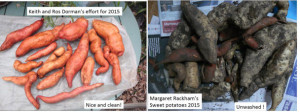
Storing:
Never put in the fridge.
They should be dried off for a few days or ‘cured’ in the sun after harvesting, and stored in a cool, airy cupboard.
Mature tubers have a long shelf life.
So, ‘Have a Go’!
